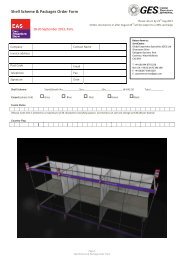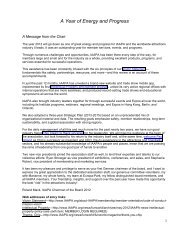Financial Statement Analysis - IAAPA
Financial Statement Analysis - IAAPA
Financial Statement Analysis - IAAPA
You also want an ePaper? Increase the reach of your titles
YUMPU automatically turns print PDFs into web optimized ePapers that Google loves.
<strong>IAAPA</strong> Seminar It’s All In the Numbers Atlanta 2006<br />
Neva Richardson – Larson<br />
Jan-Ketil Nyborg
It is All in the Numbers<br />
14<br />
25<br />
88<br />
67<br />
79<br />
56<br />
2<br />
99<br />
49<br />
12<br />
36<br />
101<br />
43<br />
8<br />
44<br />
124<br />
5<br />
87 6<br />
220
<strong>Financial</strong> <strong>Statement</strong> <strong>Analysis</strong><br />
Neva Richardson-Larson<br />
Jan-Ketil Nyborg<br />
McGraw-Hill/Irwin<br />
©The McGraw-Hill Companies, Inc. 2006
Factors in Communicating<br />
Useful Information<br />
The primary objective of accounting is to provide<br />
information useful for decision making. To provide<br />
information that supports this objective, accountants must<br />
consider the following:<br />
Users<br />
Types of<br />
Decisions<br />
Means of<br />
<strong>Analysis</strong>
Methods of <strong>Analysis</strong><br />
Horizontal<br />
<strong>Analysis</strong><br />
Vertical<br />
<strong>Analysis</strong><br />
Ratio<br />
<strong>Analysis</strong>
Milavec Company <strong>Financial</strong><br />
<strong>Statement</strong>s
Milavec Company <strong>Financial</strong><br />
<strong>Statement</strong>s
Horizontal <strong>Analysis</strong><br />
Horizontal analysis (or trend analysis)<br />
refers to studying the behavior of<br />
individual financial statement items<br />
over several accounting periods.<br />
Absolute<br />
Amounts<br />
Percentage<br />
<strong>Analysis</strong>
Milavec Company Horizontal<br />
<strong>Analysis</strong><br />
Insert Exhibit 13-3<br />
Here
Vertical <strong>Analysis</strong><br />
Vertical analysis uses<br />
percentages to compare<br />
individual components of<br />
financial statements to a<br />
key statement figure. A<br />
common-size<br />
financial<br />
statement is a vertical<br />
analysis in which each<br />
financial statement item is<br />
expressed as a<br />
percentage.
Vertical <strong>Analysis</strong> of Income<br />
<strong>Statement</strong><br />
In income<br />
statements, all<br />
items are<br />
usually<br />
expressed as a<br />
percentage of<br />
sales.
Milavec Company Vertical<br />
<strong>Analysis</strong><br />
Insert Exhibit 13-4<br />
Here
Vertical <strong>Analysis</strong> of Balance<br />
Sheet<br />
In balance<br />
sheets, all items<br />
are usually<br />
expressed as a<br />
percentage of<br />
total assets.
Milavec Company Vertical<br />
<strong>Analysis</strong>
Ratio <strong>Analysis</strong><br />
Ratio analysis<br />
involves studying<br />
various<br />
relationships<br />
between different<br />
items reported in<br />
a set of financial<br />
statements.
Liquidity Ratios<br />
Liquidity ratios indicate a<br />
company’s ability to pay shortterm<br />
debts. They focus on<br />
current assets and current<br />
liabilities.<br />
1. Working Capital<br />
2. Current Ratio<br />
3. Quick Ratio<br />
4. Accounts Receivable Ratios<br />
5. Inventory Ratios
Working Capital<br />
The excess of current assets<br />
over current liabilities is<br />
known as working capital.
Current Ratio<br />
Current<br />
Ratio<br />
=<br />
Current Assets<br />
Current Liabilities<br />
The current ratio measures a<br />
company’s short-term debt<br />
paying ability.<br />
A declining ratio may be a<br />
sign of deteriorating financial<br />
condition, or it might result<br />
from eliminating obsolete<br />
inventories.
Current Ratio
Quick (Acid-Test) Ratio<br />
Acid-Test<br />
Ratio<br />
=<br />
Quick Assets<br />
Current Liabilities<br />
Quick assets include Cash,<br />
Current Marketable Securities, and<br />
Accounts Receivable.<br />
This ratio measures a company’s<br />
ability to meet obligations without<br />
having to liquidate inventory.
Quick (Acid-Test) Ratio
Accounts Receivable Turnover<br />
Accounts<br />
Receivable<br />
Turnover<br />
=<br />
Net Credit Sales<br />
Average Accounts Receivable<br />
This ratio measures how many<br />
times a company converts its<br />
receivables into cash each year.
Accounts Receivable Turnover<br />
INSERT Insert<br />
17, p. 542,<br />
Text Box here
Average Days to Collect<br />
Receivables<br />
Average<br />
Collection<br />
Period<br />
=<br />
365 Days<br />
Accounts Receivable Turnover<br />
Average<br />
Collection<br />
Period<br />
=<br />
365 Days<br />
16.98 Times<br />
= 21 days<br />
This ratio measures, on average,<br />
how many days it takes to collect<br />
an accounts receivable.
Inventory Turnover<br />
Inventory<br />
Turnover<br />
=<br />
Cost of Goods Sold<br />
Average Inventory<br />
This ratio measures how many<br />
times a company’s inventory has<br />
been sold and replaced during<br />
the year.
Inventory Turnover<br />
INSERT Insert<br />
20, p. 543,<br />
Text Box here
Average Days to Sell<br />
Inventory<br />
Average<br />
Sale Period = 365 Days<br />
Inventory Turnover<br />
Average<br />
Sale Period =<br />
365 Days<br />
10.80 Times<br />
= 34 days<br />
This ratio measures how many<br />
days, on average, it takes to sell<br />
the inventory.
Solvency Ratios<br />
Solvency ratios are used to<br />
analyze a company’s long-term<br />
debt-paying ability and its<br />
financing structure.<br />
1. Debt to Assets Ratio<br />
2. Debt to Equity Ratio<br />
3. Number of Times Interest Earned<br />
4. Plant Assets to Long-Term Liabilities
Debt to Assets Ratio<br />
Debt to<br />
Assets<br />
Ratio<br />
=<br />
Total Liabilities<br />
Total Assets<br />
This ratio measures the percentage<br />
of a company’s assets that are<br />
financed by debt.
Debt to Equity Ratio<br />
Debt to<br />
Equity<br />
Ratio<br />
=<br />
Total Liabilities<br />
Stockholders’ Equity<br />
This ratio indicates the relative<br />
proportions of debt to equity on<br />
a company’s balance sheet.<br />
Stockholders like a lot of<br />
debt if the company can<br />
take advantage of<br />
positive financial<br />
leverage.<br />
Creditors prefer less<br />
debt and more equity<br />
because equity<br />
represents a buffer of<br />
protection.
Debt to Assets and Debt to<br />
Equity Ratios
Number of Times Interest<br />
Earned Ratio<br />
Times<br />
Interest<br />
Earned<br />
=<br />
Earnings before Interest Expense<br />
and Income Taxes<br />
Interest Expense<br />
This is the most common<br />
measure of a company’s ability<br />
to provide protection for its<br />
long-term creditors.
Number of Times Interest<br />
Earned Ratio
Plant Assets to Long-Term<br />
Liabilities<br />
Plant Assets<br />
to Long-Term<br />
Liabilities<br />
=<br />
Net Plant Assets<br />
Long-Term Liabilities<br />
This ratio suggests how well<br />
long-term debt is managed to<br />
finance long-term assets.
Plant Assets to Long-Term<br />
Liabilities
Profitability Ratios<br />
Profitability ratios measure a<br />
company’s ability to generate<br />
earnings.<br />
1. Net Margin (or Return on Sales)<br />
2. Asset Turnover Ratio<br />
3. Return on Investment<br />
4. Return on Equity
Net Margin<br />
Net<br />
Margin<br />
=<br />
Net Income<br />
Net Sales<br />
This measure describes the percent<br />
remaining of each sales dollar after<br />
subtracting other expenses as well as<br />
cost of goods sold.
Net Margin
Asset Turnover Ratio<br />
Asset<br />
Turnover<br />
=<br />
Net Sales<br />
Average Total Assets<br />
This ratio measures how many<br />
sales dollars were generated<br />
for each dollar of assets<br />
invested.
Asset Turnover Ratio
Return on Investment (ROI)<br />
Return on<br />
Investment<br />
=<br />
Net Income<br />
Average Total Assets<br />
This is the ratio of wealth generated<br />
(net income) to the amount invested<br />
(average total assets).
Return on Investment (ROI)
Return on Equity<br />
Return on<br />
Equity<br />
=<br />
Net Income<br />
Average Total Stockholders’<br />
Equity<br />
This measure is often used to measure<br />
the profitability of the stockholders’<br />
investment.
Return on Equity
Stock Market Ratios<br />
Stock market ratios analyze the<br />
earnings and dividends of a<br />
company.<br />
1. Earnings Per Share<br />
2. Book Value<br />
3. Price-Earnings (PE) Ratio<br />
4. Dividend Yield
Earnings Per Share<br />
Earnings<br />
per<br />
Share<br />
=<br />
Net Earnings Available for Common Stock<br />
Average Number of Outstanding Common<br />
Shares<br />
This measure indicates how much<br />
income was earned for each share of<br />
common stock outstanding.
Earnings Per Share
Book Value Per Share<br />
Book Value<br />
per Share<br />
=<br />
Stockholders’ Equity - Preferred Dividends<br />
Outstanding Common Shares<br />
This ratio measures the amount that would be<br />
distributed to holders of each share of common<br />
stock if all assets were sold at their balance sheet<br />
carrying amounts and if all creditors were paid off.
Book Value Per Share
Price-Earnings Ratio<br />
Price-Earnings<br />
Ratio<br />
=<br />
Market Price Per Share<br />
Earnings Per Share<br />
This ratio compares the earnings of a<br />
company to the market price for a share<br />
of the company’s stock.
Dividend Yield<br />
Dividend<br />
Yield<br />
=<br />
Dividends Per Share<br />
Market Price Per Share<br />
This ratio identifies the return, in terms<br />
of cash dividends, on the current<br />
market price of the stock.
Presentation of Analytical<br />
Relationships
Presentation of Analytical<br />
Relationships<br />
Insert Exhibit<br />
13-8 Here
Presentation of Analytical<br />
Relationships<br />
Insert Exhibit<br />
13-9 Here
Limitations of <strong>Financial</strong><br />
<strong>Statement</strong> <strong>Analysis</strong><br />
Different Industries<br />
Changing<br />
Economic<br />
Environment<br />
Accounting<br />
Principles
Jan Ketil Nyborg
BALANCE SHEET TUSENFRYD AS<br />
All amounts in NOK 1000<br />
ASSETS<br />
Fixed assets<br />
Fixed assets/work in progress<br />
Shares/pension funds<br />
Total fixed assets<br />
Current assets<br />
Inventories<br />
Accounts receivable<br />
Cash, bank<br />
Total current assets<br />
TOTAL ASSETS<br />
EQUITY AND LIABILITIES<br />
Equity<br />
Share capital<br />
Profit/loss for the year<br />
Other equity<br />
Total equity<br />
Long term liabilities<br />
Current liabilities<br />
Accounts payable<br />
Dividend<br />
Taxes payable<br />
Bank overdraft<br />
Other current liabilities<br />
Total current liabilities
Fixed Assets<br />
Sales<br />
divided by<br />
Total Assets<br />
Total Assets<br />
Turnover<br />
Current Assets<br />
multiplied by<br />
Return on<br />
assets<br />
P & L<br />
Profit before<br />
tax<br />
adding back<br />
interest costs<br />
divided by<br />
Profit margin<br />
Sales
Fixed Assets<br />
Acc.<br />
Receivable<br />
Sales<br />
divided by<br />
Equity<br />
Equity<br />
turnover<br />
Inventories<br />
multiplied by<br />
Return on<br />
equity<br />
Profit before tax<br />
P & L<br />
divided by<br />
Profit margin<br />
Sales
Profit before<br />
interest costs<br />
Interest costs<br />
minus =<br />
Profit before<br />
tax<br />
100<br />
Total Assets<br />
1000<br />
50<br />
50<br />
Long term<br />
liabilities<br />
600<br />
Equity<br />
400<br />
Return on assets 10%<br />
Return on equity 12,5%
Performance Ratios<br />
Ratio Category<br />
Current Ratio<br />
Retail Inventory<br />
Food & Beverage Inventory Ratio<br />
Operating Profit Margin<br />
Net Profit Margin<br />
Return on Assets<br />
Return on Equity<br />
Debt to Equity<br />
Capex Ratio<br />
Total<br />
3.3/1.2<br />
3.7/2.2<br />
10.9/10.6<br />
9.9/4.4<br />
3.4/1.1<br />
2.7/0.6<br />
4.5/4.1<br />
0.5/0.3<br />
0.6/0.5<br />
Information is in the <strong>IAAPA</strong> 2004 Edition<br />
“Managing Attractions for More Profit”
Information Sources<br />
• Speakers:<br />
Neva Richardson – Larson, Sims Group &<br />
Department Chair & Professor of Business for<br />
FMU an affiliate of Corinthians College.<br />
Jan-Ketil Nyborg, TusenFryd Norway<br />
• Book: Fundamentals of Managerial Accounting;<br />
Boston: McGraw-Hill

















